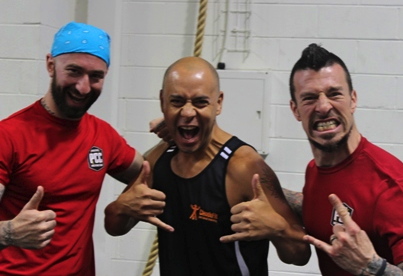
I have a new fondness and respect for all things bodyweight since completing the Progressive Calisthenics (PCC) course in Australia this past February and successfully passing the “Century” test.
As a lifter, I typically liked to lift what I thought of as “heavy stuff.” However this “stuff” was rarely my own bodyweight. It was obvious from the start that I would have my work cut out for me!
When the PCC initially came to my attention approximately 6 months before the workshop. I immediately jumped on it, and paid my registration while thinking, “Time to get it done and earn another worthwhile certification!”
My next thought was that I’d never been heavily into bodyweight training… What would I do to prepare? Had I mixed up my ambition with my ability?
This had to change!
Previously, I dropped my own body weight down from a solid 92kg frame to a leaner (and much more comfortable) 78kg . I had made that change with a focus on running and the desire to be a more complete trainer. So, it wasn’t long before I was playing around with my own weight while preparing for the PCC. Fortunately I have both of the Convict Conditioning books along with a reasonable library of other resources which allowed me to plan accordingly and meet the workshop testing criteria.
My programming was designed around the following basic movements. Please note these were not all performed on the same day.
- Chin-up & push-up variations.
- Pistol squats
- Hanging leg raises (now my go-to abs exercise)
- Running. Well it is bodyweight!
- Bridges
- Handstand /play holds and handstand pushups
- Bodyweight dips on gymnastic rings
- All the stretches I knew!!!
I worked with a basic 5×5 based strength protocol for all the movements. The benefit of this for me was that I had already applied it to barbells and kettlebells with success. Now, given my fondness of the protocol, it worked for my bodyweight training.
Sometimes I needed to switch to a simple 3×3 depending on how fried my body felt from an overloaded workout the day before–a rookie mistake that I often made from stubbornness. It’s a different kind of hurt when the nervous system is depleted! Take my word for it!
The only other major variation was on the days when I felt good and decided to put in more volume. For example a 15 x 5 set on the chins up–clearly I like chin ups! They’re the one movement that petrifies the newbies and are the base test entry for the RKC cert. So out of fear, I already had the “money in the bank“ with regard to pull ups. I now actually enjoy them!
With my new enthusiasm and lower body weight, I was well on my way towards my plan to pass the PCC.
I like to plan, so my first stop was asking myself, what does it take to pass? How long do I have? And then work backward from there.
To pass the PCC I’d have to do the following in less than 8 minutes:
- FULL SQUATS: 40 reps
- FULL PUSH-UPS: 30 reps
- HANGING KNEE RAISES: 20 reps
- FULL PULL-UPS: 10 reps
TOTAL: 100 reps
At first this seemed like a reasonable request. I gave it a go, sort of completed it and thought it wasn’t too bad. This was another rookie mistake! Later on I realized I would have to do the test after 3 days of intense bodyweight training, and had to finish each exercise in one set with strict form!
Fortunately for me, this was a great big wake up call. I prepared myself accordingly with a solid base of general physical preparation (GPP). I turned up to the workshop ready to be taught, and was physically conditioned to at least perform the basic exercises. I was there to learn and not get hurt because of a lack of conditioning. It costs money to attend these courses and it’s a total waste for all if you turn up unprepared.
Many movements are taught–push-ups and variations, chins and variations, front levers, back levers, pistols, and floor holds–just to name a few. And let’s not forget the muscle ups!
I take a casual approach to these workshops because I like to have fun and absorb the knowledge as it is taught. As I know these guys are not going to just hand your certification to you just because you’ve shown up to the workshop. So I make a point of getting myself adequately prepared and ready by cert time. No excuses.
You have to earn it, so be warned!
It was clearly one of the more enjoyable workshops that I have attended. Along with the incredible manual, the information I now have access to will keep me and my clients busy and challenged for a long time to come.
Now off to the bar for some much needed practice!

